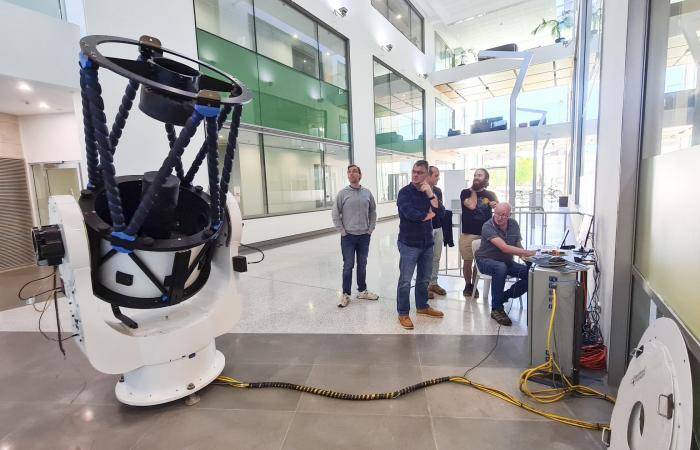An optical communications station is to be built in Western Australia that can receive high-speed data transmissions from space.
The advanced communications ground station can receive data from spacecraft anywhere between near-earth orbit and the lunar surface.
It has the potential to support groundbreaking space projects, including NASA’s Artemis mission to land the first woman and next man on the moon by 2024.
The station will be installed at the University of Western Australia (UWA).
It is a joint initiative of the UWA Astrophotonics Group, which is part of the International Center for Radio Astronomy Research (ICRAR), as well as the ARC Competence Center for Technical Quantum Systems (EQUS) and the British industrial partner Goonhilly Earth Station.
Dr. Sascha Schediwy, head of the ICRAR-UWA Astrophotonics Group, said optical communication is an emerging technology that is set to revolutionize data transfer from space.
“Most of today’s space communications are based on radio waves – it’s the same technology that brought us the voice of Neil Armstrong when the 1969 Apollo 11 mission landed on the moon,” he said.
“Optical laser communication in free space offers several advantages over radio, including significantly faster data rates and hack-proof data transmission. It’s the next generation of space communications, and it’s likely as we’ll see high-resolution footage of the first woman walking on the moon. ”
The ground station was launched today on the occasion of the world’s leading space event, the International Astronautical Congress.
It will be part of a larger network of Australian optical ground stations led by the Australian National University and with partners in South Australia and New Zealand.
EQUS Director Professor Andrew White said the project, which could be the first optical communications station in the sky in the southern hemisphere, is a prime example of basic research that is producing real results.
“EQUS has great impact by encouraging and empowering our employees to translate their research into concrete technologies and applications. We are building a culture of innovation, translation and commercialization among quantum science researchers in Australia. ”
In addition to space communication, the ground station could also be used for applications ranging from state-of-the-art basic physics to precision geosciences and resource geophysics.
Professor White said the ground station would help develop the “quantum internet” – a secure global data transmission using quantum key distribution over optical links to quantum satellites.
He said it will be an example of how cutting-edge science works with forward-thinking companies and creates an impact for both.
The station will use an observatory-grade optical telescope, 0.7 m long, donated to ICRAR by Colin Eldridge of Perth.
It will be equipped with an advanced air noise suppression technology that was developed at UWA.
The station will be connected to Goonhilly’s supercomputing center in Cornwall via high-speed fiber.
Goonhilly takes care of data traffic and supports secure communication links for the world’s largest satellite operators, including Intelsat, Eutelsat and SES Satellites.
The company is also a partner in the European Space Agency’s Lunar Pathfinder mission, which is scheduled to launch in 2022.
Ian Jones, CEO of Goonhilly, said he was delighted to partner with ICRAR and EQUS to establish an optical communications ground station in Western Australia.
“We have been at the forefront of satellite communications since the beginning of the space age, and this drives them into the next generation of systems and technologies to support the vast amounts of data generated by space missions,” he said.
“This data comes from science and other missions, and will come from lunar and mars missions in the future that include remote operations, robotics and AI. We are proud to be joint pioneers in the practical implementation of coherent optical communication. ”
Dr. Schediwy said WA ground station will help launch Australia’s space communications capability.
“This will cement Australia’s position as a leader in optical data transmission and enable the nation to enter the multi-billion dollar space communications market,” he said.
The $ 535,000 station is expected to be on-sky in early 2021 and open for operations later this year.
New ground station brings laser communication closer to reality
Provided by the International Center for Radio Astronomy Research (ICRAR)
Quote: Moon to Earth: Western Australia hosting the Space Communication Station (2020, October 12), accessed October 12, 2020 from https://phys.org/news/2020-10-moon-earth-western-australia-host.html
This document is subject to copyright. Except for fair trade for the purpose of private study or research, no part may be reproduced without written permission. The content is provided for informational purposes only.
These were the details of the news Western Australia to host the space communications station for this day. We hope that we have succeeded by giving you the full details and information. To follow all our news, you can subscribe to the alerts system or to one of our different systems to provide you with all that is new.
It is also worth noting that the original news has been published and is available at de24.news and the editorial team at AlKhaleej Today has confirmed it and it has been modified, and it may have been completely transferred or quoted from it and you can read and follow this news from its main source.

